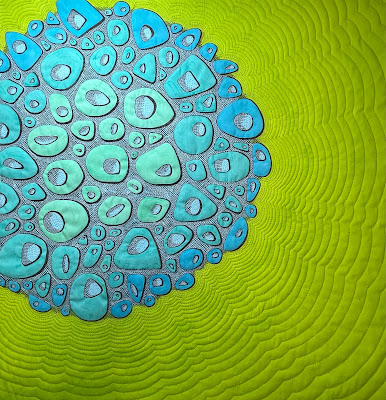Yes – it’s
kinda crazy! This is the jacket I made from an old, damaged quilt. Overall, I
love it, even though it’s rather weird because of the large-scale design on the
quilt. Here are the details:
I used the Tamarack Jacket pattern by Grainline Studio, and it was terrific.
Very clear and well-written. (The designer also has a series of wonderfully instructive
videos on YouTube that walk you through every step. Highly recommend.) This is a great
pattern if you are someone who does not do much garment construction (or any).
I have limited experience (my mom’s instruction; she was a home economics
teacher before I was born), and making a bunch of Halloween costumes for my
kids when they were little. I made this jacket in one (long) day in my studio.
I used my regular size (there's
guidance for measuring yourself and using the sizing chart that is very
helpful). The finished coat fits me very well. I love that it's not overly
bulky through the arms, because that can make you look like the Stay-Puft
Marshmallow Man. It has small darts at the bust that also help it fit well.
I chose this pattern because it is pretty simple, with large uninterrupted
areas for quilt pattern to show, and I made it simpler by leaving off the pockets
(because of the green and red applique design running down the front panels). I
also made it 6 inches longer. The original falls at the hips (usually not a
flattering look on me), and I wanted to feature more of the quilt design.
If you are working from regular
fabric (not a quilt), the instructions have you cut out all the pattern pieces
from all three layers of what quilters call “the quilt sandwich” – the top, the
batting, and the backing – and then layer them and quilt them. I’d recommend
cutting out all the pieces with about 1” extra, quilting it, and then cutting
out the pattern pieces, because if you quilt heavily, it’s going to shrink in
size, sometimes a LOT, in my experience.
There’s binding around all the
outer edges, but next time, I may just roll the edges under, like I did on the sleeve
cuffs. I also ended up folding under the front edges of the jacket (the placket)
and stitching them down, because there was way too much overlap (I think I cut
out the pattern designed for buttons and button holes). And I rather liked how
it looked with the pattern going all the way to the edge, without being
interrupted by a binding. If I do bind the edges, I’ll stitch the first side on
by machine and finish on the back with hand stitching. I can do a much prettier
job by hand.
You can order a paper pattern, but as usual, I wanted it NOW. So I downloaded
the PDF pattern (it comes in tiles/sections and you print them out and tape
them together.) I’m going to make this jacket again, probably with pockets.
Maybe with a quilt of my own design. The main pattern comes with patterns and instructions
for a welt pocket, and Grainline also makes a pattern for a hood, collar and
patch pockets, if you want those.
The old quilt I used had
extremely thin batting (before cutting it open, I wouldn’t have believed that
it had any batting at all). I think it may have been hand-carded cotton. I love
how lightweight and drapey it is. So when I do it again, I will probably use the
thinnest cotton or wool I can find. I haven’t done any kind of closures yet,
and I may not do any.
https://grainlinestudio.com/products/tamarack-jacket?variant=22533585502290
Tamarack Jacket ($20 for paper
pattern, $18 for a PDF)
Tamarack Hood, Collar &
Patch Pockets Variation Add-on ($12, PDF only)

































































